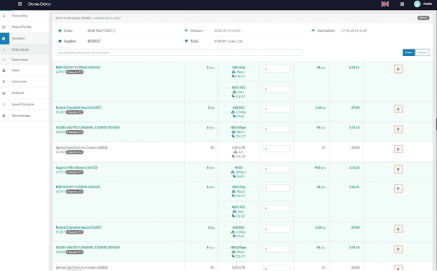Whether you’ve established a thriving restaurant, or you’re trying to make ends meet, being able to reduce restaurant costs without compromising quality requires a delicate balancing act. But in today’s rapidly evolving sector more and more operators are embracing technology to lower restaurant operating costs. With this in mind, let’s explore 5 areas in which the implementation of next-gen tech such as Syrve can have an transformative impact on your business.
1. Inventory and Supplier Alignment
Reducing operational expenses in restaurants requires a robust system for managing inventory levels. Your warehouse inventory should ideally match the demand for your products, but accurately calculating expenses and planning purchases can be challenging. Reports are cumbersome to generate, and balance data is often outdated due to weekly accounting updates.
Additionally, missed orders to suppliers and delayed deliveries result in either overordering or stockouts. In the long run, this is going to have an impact on your revenue and increase the cost of goods sold (COGS).
The answer is to implement an automated resource control loop with a self-driving restaurant management platform. This system relies on sales statistics to generate sales forecasts, which then drive automated procurement plans and supplier orders.
.jpg?width=636&height=424&name=4.02_incontent1(1).jpg)
Syrve Solution
Syrve automatically aligns your inventory with delivery schedules and sends reminders for employees to update stock counts. Guided inventory checks also direct your team to the correct storage areas, presenting them with pre-filled item lists.
Ultimately, this eliminates human error from the ordering process, significantly reducing wastage and lowering your COGS.
2. Minimise Waste Due to Write-Offs
Restaurant write-offs are a common problem. Typically, they’re the result of operational inefficiencies and poor back-of-house practices. The main culprits tend to be inaccurate demand forecasting, menu changes and overproduction, all of which lead to spoilage, write-offs and wastage.
To avoid these, you’re going to need a detailed kitchen plan that stipulates when, how much, and what type of preparations are needed for every single dish. It’s incumbent upon you to ensure that your staff follow this plan upon starting their shift.
Easily accessible historical sales data is also essential. Without it, you won’t be able to accurately predict future demand trends or take into account seasonality, local events and holidays.
.jpg?width=636&height=424&name=4.02_incontent2(1).jpg)
Syrve Solution
Syrve uses AI to help control food costs in restaurants, analysing past data and monitoring customer preferences to produce extremely accurate restaurant forecasts that allow you to anticipate demand. The ordering process is also automated which ensures that only the necessary quantities are ordered in.
In the kitchen, Syrve's fully-integrated system automatically generates prep plans for each dish so that your staff know the precise amount of ingredients to include with every order. Workflows are therefore streamlined and waste dramatically reduced.
3. Reduce Restaurant Food Costs With Better Supplier Management
Procurement is another area in which restaurant often lost money hand over fist. Higher food prices, price discrepancies, food quality issues and poor communication can all take their toll on your bottom line. Irregular deliveries and overdue payments further complicate the issue. As with the actual ordering process, gut instinct isn’t enough here.
So how do you reduce restaurant food costs? By analysing your suppliers. To make informed decisions about which suppliers to stick with and which ones to drop, accurate data about the performance of each supplier is essential.
You’ll want to know the nitty gritty regarding pricing, food quality, discrepancies and timeliness of delivery. With access to this data and the ability to compare and contrast, you’ll be much better placed to direct your spend in the right direction and cut restaurant costs.
(1).jpg?width=636&height=424&name=4.02_incontent3%20(1)(1).jpg)
Syrve Solution
Syrve includes powerful tools for monitoring suppliers, including profitability analysis and error identification. Profitability analysis allows you to review restaurant food costs and gauge the financial impact of supplier changes. Error identification makes it easier to pinpoint discrepancies in pricing, late deliveries and food quality.
4. Optimise Your Menu
A bloated, complicated and poorly-priced menu can ruin a restaurant, not matter how well its run behind the scenes. Preparing dishes turns into a nightmare for chefs, while the procurement process becomes convoluted and inefficient. What’s more, a rigid menu that isn’t adjusted according to seasonal or demand fluctuations is going to put off customers, lead to waste and cause an inventory imbalance.
Optimising your menu requires insightful data that provides information about every single dish on your menu. Historical sales data is especially important, allowing you to predict future demand and avoid over/under stocking.
Understanding what sells and what doesn’t is another critical requirement. The problem with all this is that many restaurant owners simply do not have easy access to such data, even in today’s tech-driven industry. But keeping restaurant expenses down depends on heavily on a properly-balanced menu.
.jpg?width=636&height=424&name=4.02_incontent4(1).jpg)
Syrve Solution
One of Syrve's standout features is its suite of menu management tools, particularly its ABC/XYZ analysis module. Traditionally used in manufacturing, ABC/XYZ is a management model that categorises items according to their inherent value within an inventory framework. Items are also arranged based on their historical performance.
This kind of system is ideal for menu and inventory management. It allows you to identify best-selling dishes and poor performers according to historical demand. Furnished with this data, it becomes much easier to make adjustments and streamline your menu. To make it easier, Syrve automates most tasks by monitoring ordering patterns and categorizing items accordingly.
5. Integrate All Processes
The F&B industry is more volatile and competitive than ever, customer expectations have skyrocketed, inflation is soaring and prices are high. In such a climate, traditional methods of managing restaurants are becoming obsolete.
To survive, it’s important to unify all of your processes, both front and back of house. To ensure, efficiency and drive success, your teams need to work in concert with each other. Friction and inflexibility should be avoided at all costs.
To retain customers, waiting times need to be short. This means simplified, streamlined order taking for your front-of-house staff. You should be able to set up and manage promotions and incentives easily.
Real-time, actionable data that’s connected and which covers all areas of your operations are absolutely essential as well. You’ll need access to comprehensive metrics about your inventory levels, kitchen ops and procurement practices.
.jpg?width=636&height=424&name=4.02_incontent6(1).jpg)
Syrve Solution
Syrve is an all-in-one restaurant management, self-driving platform which makes all of the above entirely achievable. Integrating all operational areas including your inventory, kitchen and front of house, the system provides centralised actionable data in real time, from which you can monitor and manage your entire operation.
Digital tools for restaurant cost management can transform your business from the ground up, helping to slash restaurant outgoing without compromising customer experience. Understandably, the impactful, transformative nature of the latest tech solutions has led to widescale adoption in the F&B sector. In such a challenging industry, the very future of your restaurant may depend on you doing the same.
Learn how Syrve’s best-in-class platform helps to reduce restaurant costs in each of the above 5 areas: https://www.syrve.com/




